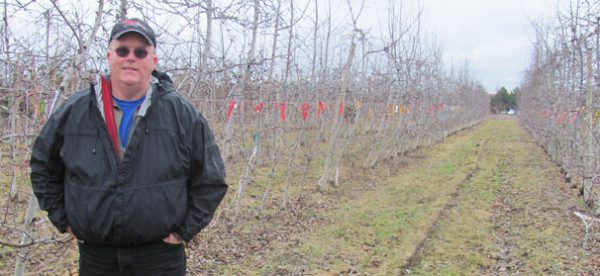
Apr 29, 2011Trials seek to fight replant disorders
Replant disorders are a major problem for apple growers, especially as new land becomes less available. Growers planting on replant sites have few effective ways to avoid losses.
To remedy the situation, the Washington Tree Fruit Research Commission and USDA’s National Apple Rootstock Breeding Program leader Gennaro Fazio have been conducting trials for nearly a decade, testing which rootstock best mitigates replant disorders.
On March 1, Tom Auvil, a research horticulturist with the commission and the lead researcher on the project, led a group of International Fruit Tree Association (IFTA) members through one of the trial plots near Wapato, Wash. Other plots are testing varieties like Honeycrisp and Fuji, but the Wapato plot is testing Brookfield Gala planted in 2004 and 2006, according to the research commission.
Based on the trial results so far, Auvil had this advice for Washington growers: If you want to mitigate replant disorders and get a nice boost in performance, use Geneva rootstock on fumigated ground.
The sites were split into fumigated and non-fumigated trials, to compare performance. The trials have clearly shown that fumigation is an essential part of establishing a new orchard on an old orchard site. In many non-fumigated sites, yields are only half of what’s needed to be economically viable, Auvil said.
If it’s not possible to fumigate, Geneva rootstocks can mitigate replant disorders better than others. According to yield data from the trials, Geneva rootstocks – particularly G.41, G.214, G.935 and G.890 – have high levels of performance in non-fumigated sites, two or three times that of rootstocks like Bud 9 or M.26, he said.
Fire blight is another big problem in the western part of the country. Nearly all apple scions are susceptible to fire blight. Combine that susceptibility with a highly susceptible rootstock, and the typical outcome is “disaster,” he said.
Several large growers are not planting apples until fire blight-resistant rootstocks are available, and would like to use the replant-resistant rootstocks with fire blight resistance (G.41 and G.214) to fill in the holes of their 3-, 4- and 5-year-old blocks that have fire blight, Auvil said.
Unfortunately, Geneva rootstocks are barely available in commercially relevant numbers. USDA and Cornell University project 2 million to 3 million finished trees available on Geneva rootstocks by 2014, but most of those finished trees will not be on the best Geneva rootstocks, he said.
Due to the productivity of the elite Geneva rootstocks and their resistance to fire blight, replant disorders, winter freeze and woolly apple aphid, all dwarf trees planted in Washington state should be on elite Geneva rootstock – but that demand is in the neighborhood of 8 million liners annually, according to Auvil.
For some additional information on rootstock varieties, click here.
By Matt Milkovich














